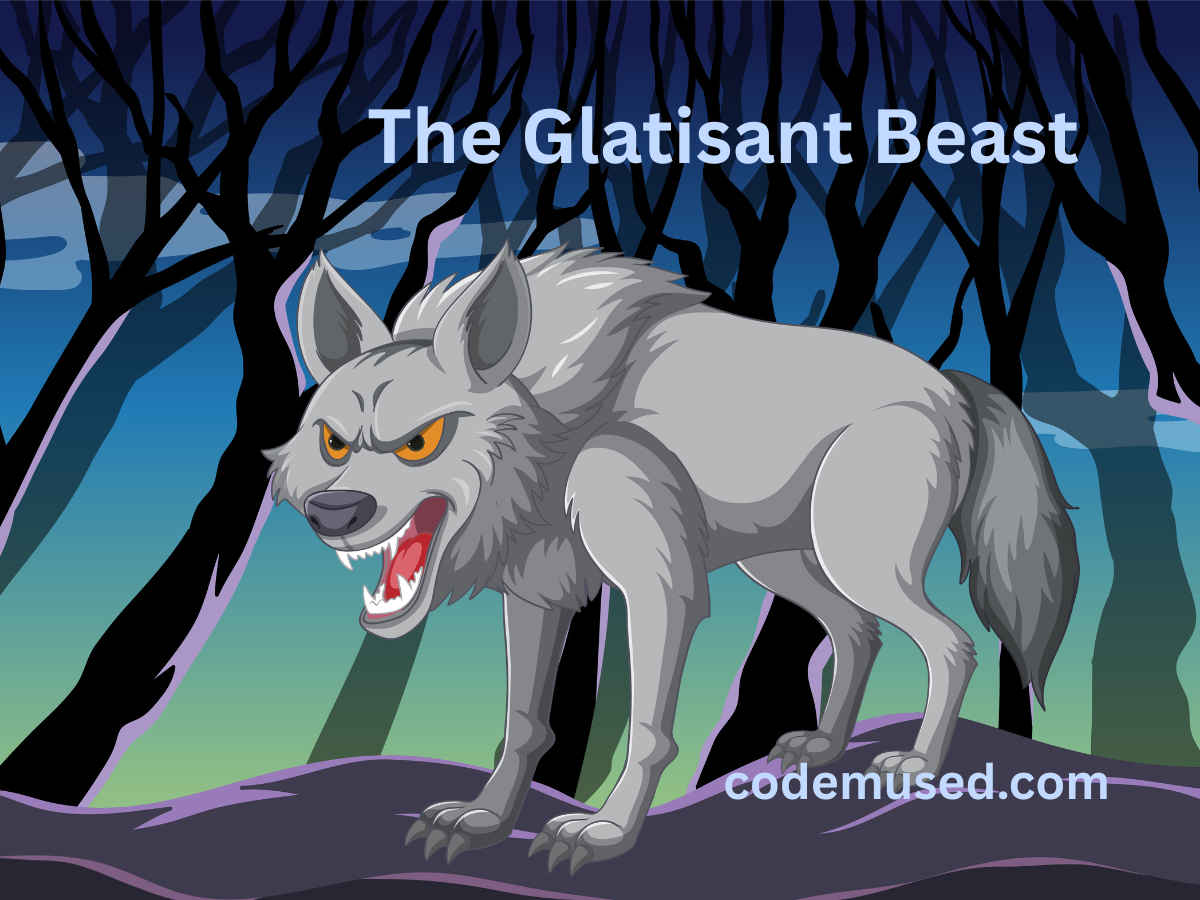Introduction
Legends are echoes of a past influenced by myth, magic, and morality; they are more than just stories. A lesser-known and intriguing creature that lurks on the fringes of Arthurian legend is the Beast Glatisant, sometimes known as “The Barking Beast.” The Beast Glatisant is a peculiar, elusive creature that has fascinated readers and academics for generations. It differs from the giants and dragons of folklore in one specific way: its voice.https://en.wikipedia.org/wiki/Questing_Beast#
This article delves into the Beast Glatisant’s history, meaning, and cultural influence, revealing its enigma and the things it still stands for in modern fantasy literature and folklore. Whether you’re a lover of King Arthur’s knights, a mythology aficionado, or a fantasy writer hunting for inspiration, this creature is worth studying.
What is the Glatisant Beast?
A legendary creature from Arthurian legend, the Beast Glatisant—also called the Questing Beast—is frequently depicted in French medieval romances. “Glatisant” is derived from the French word “glapissant,” which means “yelping” or “barking.” This moniker refers to one of the beast’s most frightful and intriguing characteristics: its ethereal barking, which is likened to “thirty hounds questing.”
An explanation of the beast
The Beast Glatisant is represented as a chimera beast, frequently with:
The head and neck of a serpent The Glatisant Beast
The leopard’s body The Glatisant Beast
The lion’s hindquarters The Glatisant Beast
The hart’s (deer’s) feet The Glatisant Beast
And a body that, even when it is silent, barks or yells The Glatisant Beast
It is not inherently hostile, but it is enigmatic, secretive, and related strongly to ideas of prophesy and fate.
Arthurian Lore is the source.
The Beast Glatisant initially appears in the Post-Vulgate Cycle and Thomas Malory’s Le Morte d’Arthur, when King Pellinore and Sir Palamedes, a Saracen knight who becomes a Christian, hunt it down. The search for the Beast turns into a lifetime endeavor, and while the beast itself makes appearances in many stories, it is never fully portrayed, at least not in the early drafts.
The Prophetic Beast
Legend has it that the Beast Glatisant was created by a combination of magic and sin. Its narrative of origin is highly symbolic:
After being turned down, a princess who has feelings for her brother accuses him of rape. She curses her lineage with the Beast Glatisant, a hideous creature, as retribution for this deception. The Glatisant Beast
This moral story emphasizes the beast’s function as a symbol of restless guilt and misguided desire by linking its existence to deception, sin, and chaos. The Glatisant Beast
Meaning and Significance
The Beast Glatisant is a walking (and barking) metaphor rather than merely a terrible animal.
1. The actual quest
According to many academics, the beast represents unreachable or limitless objectives. Uncatchable and always on the run, it is the quintessential questing animal. Knights such as Sir Palamedes or King Pellinore use the hunt as a metaphor for:
Faith (in Palamedes’ conversion to Christianity, for example)
Redemption (forgiving one’s own crimes) The Glatisant Beast
Desire vs. Duty (Pellinore giving up on battle and the pursuit of love) The Glatisant Beast
2. Guilt as the Beast
The unavoidable echoes of shame and wrongdoings are symbolized by the beast’s sinful and deceptive beginnings. Its bark could represent the constant, omnipresent, and unquiet voice of conscience. The Glatisant Beast
3. The disturbance of the natural order
Many medieval anxieties about unnatural hybrids are echoed by its peculiar composition (serpent, lion, deer, etc.). Thus, the Beast Glatisant represents disorder, moral decay, and the disintegration of social order, particularly following deception, treachery, or acts of taboo. The Glatisant Beast
The Beast in Pop Culture and Literature
The Beast Glatisant has appeared in both contemporary fantasy and classic literature, while not being as well-known as Excalibur or the Holy Grail.
Traditional Looks
Thomas Malory, author of Le Morte d’Arthur: The beast occurs several times and is essential to the journeys of both Pellinore and Palamedes.
Post-Vulgate Cycle: Its legend, including its backstory and symbolic meanings, is more fully established.
Current Citations
“The Once and Future King” by T.H. White: More comically, the beast is presented as timid, misinterpreted, and longing for company.
Even if the beast itself doesn’t show up in the BBC’s Merlin television series, it is obviously influenced by other mythological animals and concepts.
Video games and tabletop games: Dungeons & Dragons and The Witcher series both feature creatures resembling the Beast Glatisant.
Its recurring existence, even in modern incarnations, is a testament to its narrative strength and mystery.
Relationships with Other Legendary Animals
Numerous additional mythical monsters from various cultures share characteristics with the Beast Glatisant:
Chimera (Greek mythology): Greek mythology describes the chimera as a hybrid animal having several animal parts.
Manticore (Persian mythology): According to Persian mythology, a manticore is a hybrid with magical abilities.
The White Stag (Celtic and Arthurian): Like the Beast Glatisant, the Celtic and Arthurian White Stag is frequently a representation of elusive spiritual truth.
These analogies demonstrate a shared human fascination with beings that merge the real and the fantastical.
The Significance of the Beast Glatisant
The archetype of the elusive beast is still prevalent in contemporary storytelling, whether it is in fantasy literature, motion pictures, or video games. We learn from the Beast Glatisant that:
There are quests that are more significant than their conclusion.
The past can resonate louder than we think.
Some monsters are mirror images; not all monsters are malevolent.
The Beast Glatisant is a rich source of metaphor, plot structure, and character motivation for authors, readers, and mythologists.
Conclusion
With its bizarre form and eerie bark, the Beast Glatisant may not be as well-known as unicorns or dragons, but its meaning is just as potent. It stands for the never-ending search, the weight of the truth, and the difficult path to salvation. It reminds us that not all monsters are designed to be killed and forces us to face the things that cannot be silenced: guilt, desire, faith, and fate.
The Beast Glatisant, elusive, tragic, and deeply human, roams the middle ground in a world full of obvious heroes and villains.
Thus, keep in mind that you might be pursuing your own Beast Glatisant the next time you are plagued by a persistent voice, an idea, or a purpose.
One of the most common questions (FAQs) is:
Q1: Is the Beast Glatisant malevolent?
No, the beast isn’t always bad. The beast itself is more symbolic than malevolent, even though its birth is connected to a sinister story of deception and sin. More accurately, it is a misinterpreted monster that stands for fate, blame, and the illusive truth.
Q2: Who pursues the Glatisant Beast?
The beast is initially pursued by King Pellinore, then by his son, and last by Sir Palamedes. Every knight has a lengthy journey that is full of failure and personal development.
Q3: What does the barking of the beast indicate?
The barking is symbolic and is compared to thirty hounds. It might stand for turmoil, guilt, or the clamor of a restless spirit. In the Arthurian realm, it also identifies the beast as a singular and unnerving being.
Q4: Has the Beast Glatisant ever been captured?
Because of its nature as an unending pursuit, the beast is never captured in the majority of ancient tales. But in some contemporary adaptations or interpretations, authors have decided to bring the chase to a close.
Q5: Is Glatisant the Beast real?
No. With no genuine zoological foundation, the Beast Glatisant is a mythological beast from Arthurian romance fiction. It only occurs in storytelling traditions and folklore.









